Wabi-sabi is a design philosophy that celebrates the beauty of the imperfect, the transient, and the natural. It originated in Japan and has gained popularity in interior design thanks to its minimalist and cozy approach. If you want to learn more about this style and why it's so trendy, here's everything you need to know.
What is wabi-sabi style?
Wabi-sabi is a Japanese aesthetic that values imperfection, simplicity, and the ephemeral nature of things. Rather than seeking perfection, this style embraces the traces of time, natural materials, and simple forms. It's a style that invites reflection and appreciation of the little things, bringing peace and serenity to the space.
Characteristics of the wabi-sabi style
Imperfection and asymmetry
Wabi-sabi celebrates imperfections. This can be reflected in irregularly shaped objects or time-worn surfaces, such as a handmade ceramic mug or an aged wooden table.
Natural materials
The use of natural materials is key to the wabi-sabi style. Wood, stone, ceramics, cotton, and linen are the mainstays. These materials not only add beauty but also connect the space with nature.
Neutral and soft colors
Wabi-sabi uses neutral and soft colors, such as earth tones, grays, and beige. This creates a calm and relaxing atmosphere, ideal for a cozy home.
Empty spaces
The wabi-sabi style doesn't overwhelm spaces. Simplicity is essential, resulting in rooms with less furniture and decor, allowing the space to breathe.
Aged or worn elements
Objects that show signs of aging are often incorporated, such as a table with signs of wear or a weathered stone. This adds a sense of history and character to the home.

Why is wabi-sabi style in fashion in decoration?
The wabi-sabi style has gained popularity because it responds to the need to find peace and serenity in an increasingly fast-paced and over-burdened world. Its focus on simplicity, nature, and imperfection helps people disconnect and focus on the essential. Furthermore, this style is perfect for those seeking authentic and timeless decor, without the pressure of following the latest trends.
How to incorporate wabi-sabi style into your home
Minimalist furniture
Choose furniture with simple lines and natural materials, such as aged wood, bamboo, or linen. Furniture doesn't have to be perfect; beauty lies in imperfections.
Simple decoration
Instead of filling every corner, opt for decorative pieces that reflect natural beauty, such as ceramic vases, simple potted plants, and paintings depicting elements of nature.
Clear spaces
Let the space flow and avoid cluttering the rooms. Wabi-sabi style values the tranquility that comes from reducing clutter.
Soft lighting
Use warm, soft lights to create a cozy atmosphere. Paper lanterns, candles, and wooden lamps are perfect for this style.
Worn accessories
Add accessories that show signs of use or aging, such as a wool rug with frayed threads or a table with scuff marks.

Frequently asked questions about wabi-sabi style
What does wabi-sabi style mean?
Wabi-sabi is a Japanese aesthetic philosophy that celebrates the beauty of the imperfect, the ephemeral, and the natural. It's a way of seeing the world that values simplicity and imperfections.
How can I apply the wabi-sabi style in my home?
You can apply the wabi-sabi style to your home by using simple, natural furniture and decor, leaving empty spaces and using neutral colors. The key is to embrace imperfection and simplicity.
Why is wabi-sabi style so fashionable?
The wabi-sabi style has become popular because it offers a more peaceful way of living, less focused on material things. Its focus on imperfection and the natural responds to a growing desire to disconnect from the stress and visual overload of the modern world.
What materials are ideal for the wabi-sabi style?
The ideal materials for this style are natural and organic, such as aged wood, stone, ceramic, linen, and cotton. These materials provide a sense of authenticity and connection with nature.


0 comments